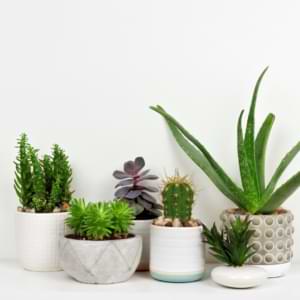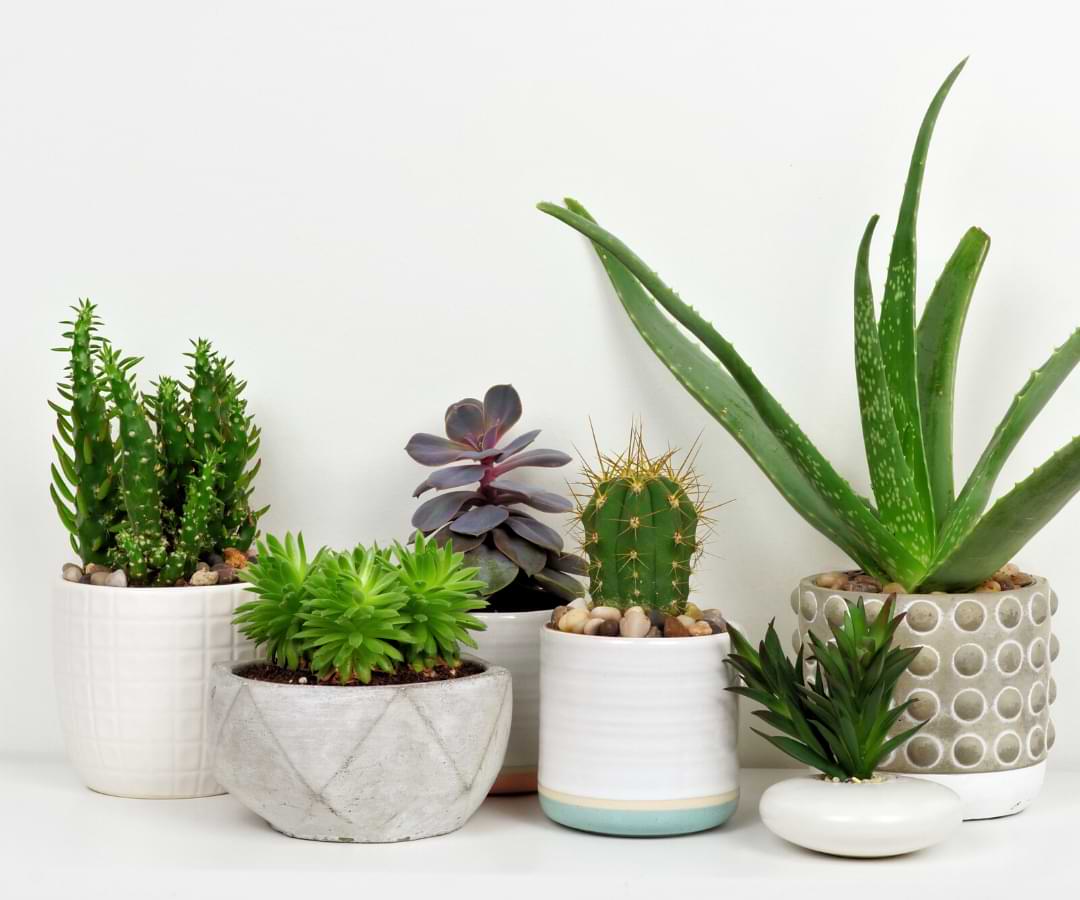Table of Contents
Guide to Houseplants
Houseplants are wildly popular right now, and for good reason! Not only are plants beautiful, but they have been shown to have health benefits such as improving indoor air quality and boosting mental health.
If you’ve wanted to get started with houseplants but aren’t sure where to even begin, don’t worry, our guide to houseplants is here to help. Even if you have a black thumb, we’ll walk you through the basics of houseplant care and the easiest plants to start with, even if you’re a totally beginner who’s never even kept a cactus alive.
Let’s get started!

The Basics of Houseplant Care
The main thing to remember about plants is that you’re trying to recreate their natural environment in your own home, and in their pot. This means that air, water, soil, and light conditions will need to be similar to wherever that plant evolved.
Luckily, most houseplants (especially the popular ones that you’ll find in most chain stores) are well-suited to live indoors. Many of these plants originate from the tropics, so they do well in partial sunlight and most normal room temperatures.
There are a few things that every plant needs, so you’ll want to pay attention to these no matter what plant you choose. Here’s a quick run-through of a houseplant’s basic wishlist:
Light
Plants need light to carry out photosynthesis, the process by which plants create food from sunlight. Some plants need more sunlight and some need less. Read this article to determine the light conditions of your space, and then seek out plants that like those conditions.
If you’re just browsing at the plant store, you can look at the legend on the tag (you’ll find this on a sticker on the pot or on a little label stuck into the soil). Light needs will usually be represented using one of three symbols: a full sun, a half-sun/half-shade symbol, or a fully darkened sun.
A full sun means bright sunlight. Put these plants right in a window.
A half sun means partial shade. Put this plant near a bright window, but not right in the sun’s rays.
A darkened sun means lower light. Put these plants a little deeper in a room with a window.

Pots
Next up in our guide to houseplants is pots. One of the biggest problems beginners have with houseplants is choosing an appropriate pot.
The plant’s pot is its whole world. It draws nutrients and water from the soil, and conditions need to be just right to keep the plant healthy and free of disease. This means that you’ll almost always need a pot with drainage holes because the soil is constantly draining in nature.
Without drainage holes, your plant’s roots might sit in water for too long, which leads to root rot! Though it is possible to grow some plants in pots without drainage, this is an advanced move that we don’t recommend for beginners.)
Start by finding a pot with drainage holes and a tray to set it on. You can also put a draining pot inside a decorative pot without drainage, and just lift the inner pot out when you water.
Soil
Different plants prefer different kinds of soil.
It’s a good idea to research your plant’s soil preferences and shop accordingly, but most of the time you’ll be fine with something light that drains well, like a cactus mix.
Whatever you do, do NOT go out in your yard and start digging up garden soil. That stuff is completely different from what most plants need and is usually too dense to drain quickly enough. Use a potting mix intended for potted plants.
Here are more tips for choosing the best soil for your houseplants.
Water
Water is an important aspect of our guide to houseplants.
Here’s another area where many new plant parents get it wrong. Some of us love our plants to death by watering them so much they drown or rot, and others completely forget about their plants until they’re a dried-out husk!
Again, it’s best to research your plant before you start watering because some plants will need more or less water than you think.
As a general rule, desert plants like succulents will need less water, and you’ll want to let the soil dry out completely between waterings. Tropical plants, on the other hand, will prefer more water and you should only let the top few inches of soil dry out before watering.
Most plants at the store will have a little raindrop symbol on the tag to let you know how much water than plant likes.
Here’s what those symbols mean:
One raindrop: This plant requires minimal moisture. Let the soil dry out completely out between waterings. This means you might only be watering once every few weeks.
Two raindrops: This plant requires normal, moderate watering. Wait until the top inch or two of soil has dried but the lower layers are still moist. This usually means you’ll be watering once a week or so.
Three raindrops: This plant likes consistently damp soil, so you’ll probably be watering every couple of days or more, depending on your climate.
Temperature and Humidity
Most plants sold as houseplants thrive in regular indoor temperatures. Unless your house is very cold or very hot, your plants will probably be fine. Just makes sure to keep your plants away from heaters, AC vents, or drafts, as this will harm many tropical plants.
As for humidity, this one is trickier. Some tropical plants need more humidity to keep their leaves supple, so you might want to supply some plants with a humidifier or keep them on a tray filled with pebbles and water if you live in a dry area. Watch your leaves for dryness and cracking to see if they want more humidity.
Use this list to find the best houseplants for your environment.
Fertilizer
Plants need nutrients just like we do!
Soil and potting mix already contain nutrients, but many plants will deplete their supply within a few months. That’s why it’s important to replenish nutrients with fertilizer after you’ve had your plants for a few months, especially during their growing season.
There are tons of different fertilizers on the market, but my favorite by far is Indoor Plant Food because you can use it on nearly all houseplants (except succulents) and it’s gentle enough to use with every watering, which means you don’t have to keep track of a fertilizing schedule! Win!
The Best Guide to Houseplants for Beginners
Are you ready to get your first houseplant? Use the tips from this comprehensive guide to houseplants. Here are our favorite low-maintenance houseplants to start building your indoor gardening skills, and links to articles about how to care for them!
Snake plants
Spider plants
Succulents
Pothos
Philodendron
Dracaena
Parlor Palm
Peace Lily
This site is full of tips and tutorials for taking great care of your houseplants, so make sure to look around! You’ll be an expert in no time!
To chat with other houseplant owners, join our Facebook community and follow us on Instagram.




